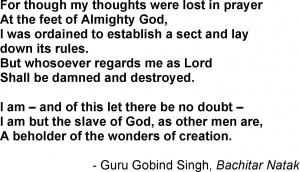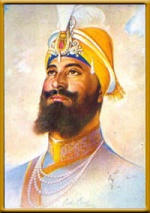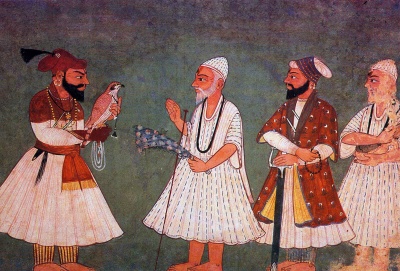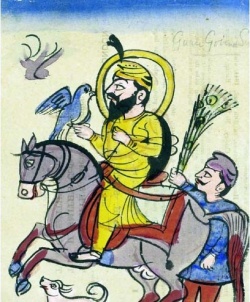Guru Gobind Singh: Difference between revisions
Navroopsehmi (talk | contribs) No edit summary |
Navroopsehmi (talk | contribs) mNo edit summary |
||
| Line 27: | Line 27: | ||
[[Image:GGSingh meets GNanakDev.jpg|thumb|400px|left|Guru Gobind Singh (with bird) encounters Guru Nanak Dev. An 18th century painting of an imaginary meeting.]] | [[Image:GGSingh meets GNanakDev.jpg|thumb|400px|left|Guru Gobind Singh (with bird) encounters Guru Nanak Dev. An 18th century painting of an imaginary meeting.]] | ||
[[Image:GGobindSingh on horseback.jpg|thumb|250px]] | [[Image:GGobindSingh on horseback.jpg|thumb|250px|A watercolour of Guru Gobind Singh on horseback. c.1800-1900. ''Victoria & Albert Museum Ref: IM.2:128-1917'']] | ||
{{Sikh Gurus|Guru Teg Bahadur|([[1 April]] [[1621]] - [[11 November]] [[1675]])|Guru Gobind Singh|Guru Granth Sahib|(Perpetual Guru of the Sikhs)}} | {{Sikh Gurus|Guru Teg Bahadur|([[1 April]] [[1621]] - [[11 November]] [[1675]])|Guru Gobind Singh|Guru Granth Sahib|(Perpetual Guru of the Sikhs)}} | ||
Revision as of 10:44, 2 January 2006
Guru Gobind Singh Ji (December 22, 1666 in Patna, Bihar, India - October 7, 1708) was the tenth and last of the Ten human form Gurus of Sikhism. He became Guru on November 11, 1675 following in the footsteps of his father Guru Teg Bahadur Ji. Before Guru Ji left his body, he nominated Sri Guru Granth Sahib Ji or SGGS as the next perpetual Guru of the Sikhs. This Granth is more than a holy book for the Sikhs. Guru Ji established the Sikh baptism ceremony, Amrit Sanchar the partaking of amrit.
Sri Guru Gobind Singh Ji (also sometimes written as 'Govind') was the last of 10 Sikh Gurus, who were the founders of the Sikh religion. The part played by this Guru in the development of the Sikh faith has been monumental. The First Sikh Guru was Guru Nanak dev Ji.
Guru Ji exemplified the teachings of Sikh principles during his lifetime. He not only taught the teachings, but he strongly and forcefully defended and sacrificed all in upholding those beliefs and teachings. Guru Gobind Singh lost his father, mother, and all four of his sons to a religious war, fought against the Mughal emperor of the time, Aurangzeb. Aurangzeb demanded that all Sikhs either convert to Islam or be killed. It was in this fight for spiritual survival the Guru Gobind Singh felt the pain of loss.
Guru Ji also finalised many elements of Sikhism. He proclaimed himself the last living Guru and established the Guru Granth Sahib -- a compilation of the ten Gurus' writings -- as the eternal guru for the Sikhs. However, it was only spiritual authority that was bestowed upon the Guru Granth. Temporal authority was given to the Khalsa.
The following is a summary of the main highlights of Guru Ji's life:
- Compilation of the Damdamni Bir, which forms the current Guru Granth Sahib.
- Author of various important Banis which Sikhs recite daily : Jaap Sahib, Chaupai, etc
- Built the various Gurdwaras - Kesh Garh Sahib etc.
- Developed Anandpur Sahib as a Sikh Centre of Excellence.
- Enhanced the Structure of Sikh Society by introducing various administration systems
- Extreme personal sacrifice for Society : Father Martyred for protection of Kashmiri Hindus, All four sons sacrificed to the Mughal and Tribal Forces.
- Sent Zafarnama to Aurangzeb.
| Preceded by: Guru Teg Bahadur (1 April 1621 - 11 November 1675) |
Guru Gobind Singh | Followed by: Guru Granth Sahib (Perpetual Guru of the Sikhs) |
| These are the Ten Gurus of Sikhism |
|
Guru Nanak | Guru Angad Dev | Guru Amar Das | Guru Ram Das | Guru Arjan | Guru Hargobind | Guru Har Rai | Guru Har Krishan | Guru Teg Bahadur | Guru Gobind Singh |
Chronology of the Main Events in Guru ji Life
| # | Date | Event |
|---|---|---|
| 1 | December 22nd, 1666 | Birth at Patna Sahib |
| 2 | May, 1673 | Arrival at Anandpur Sahib |
| 3 | July, 1677 | Marriage with Mata Jeeto Ji |
| 4 | 1682 | Repulsing the attack of Raja Bhim Chand on Anandpur |
| 5 | May, 1685 | Maklaavaa of Mata Jeeto Ji (who adopted the name 'Sundari') |
| 6 | July, 1685 | Guru Ji leaves Anandpur for Paonta Sahib |
| 7 | November, 1686 | Birth of S. Ajit Singh Ji |
| 8 | October, 1687 | Battle of Bhangani |
| 9 | November 1688 | Return to Anandpur Sahib |
| 10 | 1689 | Battle of Naudan |
| 11 | March,1690 | Birth of S. Jujhar Singh Ji |
| 12 | 1694 | Khanzada attacks Anandpur |
| 13 | 1695 | Battle with Hussain Khan |
| 14 | 1697 | Birth of S. Zorawar Singh Ji |
| 15 | 1699 | Birth of S. Fateh Singh Ji |
| 16 | Vaisakhi, 1699 | Creation of the Khalsa |
| 17 | September 1699 | Skirmishes with Raja Bhim Chand |
| 18 | December 1700 | Attacked by the combined forces of the hill chieftains |
| 19 | January 1701 | Leave Anandpur for Nirmoh |
| 20 | January 1702 | Battle of Nirmoh |
| 21 | March 1702 | Goes to Basoli April |
| 22 | June 1702 | Occupation of Kalmot |
| 23 | August 1702 | Return to Anandpur |
| 24 | February 1703 | Repulsing the attacks of the hill-chieftains |
| 25 | June 1704 | Repulsing the combined attack of hill-chiefs and Mughals |
| 26 | December 1704 | Evacuation of Anandpur |
| 27 | December 1704 | Battle of Chamkaur and martyrdom of S. Ajit Singh Ji and S. Jujhar Singh Ji |
| 28 | December 1704 | Martyrdom of S. Zorawar Singh Ji and S. Fateh Singh Ji |
| 29 | May, 1705 | Battle of Khidrana |
| 30 | June 1705 | Battle of Mukatsar |
| 31 | July 1705 | Reach Sabo-ki-talwandi (Damdama Sahib) |
| 32 | November 1705 | Start from Damdama Sahib to meet emperor Aurangzeb |
| 33 | February 1706 | Death of Aurangzeb |
| 34 | March 1706 | Guru Ji receives news of death of Aurangzeb |
| 35 | July 23rd, 1707 | Guru Ji meets Bahadhur Shah at Agra |
| 36 | November 1707 | Moves towards Deccan |
| 37 | September 1708 | Reach Nanded |
| 38 | October 7th, 1708 | Jyoti Jyot (Guru Ji leaves his body) |




